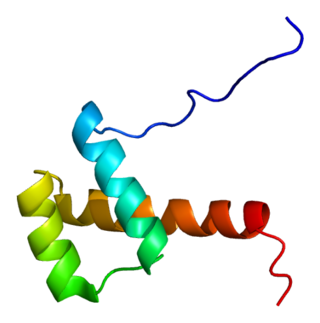Related Research Articles

Drosophila embryogenesis, the process by which Drosophila embryos form, is a favorite model system for genetics and developmental biology. The study of its embryogenesis unlocked the century-long puzzle of how development was controlled, creating the field of evolutionary developmental biology. The small size, short generation time, and large brood size make it ideal for genetic studies. Transparent embryos facilitate developmental studies. Drosophila melanogaster was introduced into the field of genetic experiments by Thomas Hunt Morgan in 1909.
The primitive node is the organizer for gastrulation in most amniote embryos. In birds it is known as Hensen's node, and in amphibians it is known as the Spemann-Mangold organizer. It is induced by the Nieuwkoop center in amphibians, or by the posterior marginal zone in amniotes including birds.

The primitive streak is a structure that forms in the early embryo in amniotes. In amphibians the equivalent structure is the blastopore. During early embryonic development, the embryonic disc becomes oval shaped, and then pear-shaped with the broad end towards the anterior, and the narrower region projected to the posterior. The primitive streak forms a longitudinal midline structure in the narrower posterior (caudal) region of the developing embryo on its dorsal side. At first formation the primitive streak extends for half the length of the embryo. In the human embryo this appears by stage 6, about 17 days.
Lefty are a class of proteins that are closely related members of the TGF-beta superfamily of growth factors. These proteins are secreted and play a role in left-right asymmetry determination of organ systems during development. Mutations of the genes encoding these proteins have been associated with left-right axis malformations, particularly in the heart and lungs.
In the field of developmental biology, regional differentiation is the process by which different areas are identified in the development of the early embryo. The process by which the cells become specified differs between organisms.

Cerberus is a protein that in humans is encoded by the CER1 gene. Cerberus is a signaling molecule which contributes to the formation of the head, heart and left-right asymmetry of internal organs. This gene varies slightly from species to species but its overall functions seem to be similar.

Homeobox protein CDX-2 is a protein that in humans is encoded by the CDX2 gene. The CDX2 protein is a homeobox transcription factor expressed in the nuclei of intestinal epithelial cells, playing an essential role in the development and function of the digestive system. CDX2 part of the ParaHox gene cluster, a group of three highly conserved developmental genes present in most vertebrate species. Together with CDX1 and CDX4, CDX2 is one of three caudal-related genes in the human genome.

Homeobox protein Hox-B6 is a protein that in humans is encoded by the HOXB6 gene.

Hematopoietically-expressed homeobox protein HHEX is a protein that in humans is encoded by the HHEX gene and also known as Proline Rich Homeodomain protein PRH.

Homeobox protein Hox-B5 is a protein that in humans is encoded by the HOXB5 gene.

Homeobox protein Hox-B1 is a protein that in humans is encoded by the HOXB1 gene.

Homeobox protein Hox-C4 is a protein that in humans is encoded by the HOXC4 gene.

Homeobox protein Hox-A3 is a protein that in humans is encoded by the HOXA3 gene.

Homeobox protein Hox-C13 is a protein that in humans is encoded by the HOXC13 gene.

Homeobox protein Hox-B8 is a protein that in humans is encoded by the HOXB8 gene.

Homeobox protein Hox-C9 is a protein that in humans is encoded by the HOXC9 gene.

Forkhead box protein A2 (FOXA2), also known as hepatocyte nuclear factor 3-beta (HNF-3B), is a transcription factor that plays an important role during development, in mature tissues and, when dysregulated or mutated, also in cancer.

Forkhead box protein J1 is a protein that in humans is encoded by the FOXJ1 gene. It is a member of the Forkhead/winged helix (FOX) family of transcription factors that is involved in ciliogenesis. FOXJ1 is expressed in ciliated cells of the lung, choroid plexus, reproductive tract, embryonic kidney and pre-somite embryo stage.

Homeobox protein CDX-4 is a protein that in humans is encoded by the CDX4 gene. This gene is a member of the caudal-related homeobox transcription factor family that also includes CDX1 and CDX2.
Left-right asymmetry is the process in early embryonic development that breaks the normal symmetry in the bilateral embryo. In vertebrates, left-right asymmetry is established early in development at a structure called the left-right organizer and leads to activation of different signalling pathways on the left and right of the embryo. This in turn cause several organs in adults to develop LR asymmetry, such as the tilt of the heart, the different number lung lobes on each side of the body and the position of the stomach and spleen on the right side of the body. If this process does not occur correctly in humans it can result in the syndromes heterotaxy or situs inversus.
References
- ↑ The UniProt Consortium; UniProt: the universal protein knowledgebase. Nucleic Acids Res 2017; 45 (D1): D158-D169. doi: 10.1093/nar/gkw1099.
- 1 2 NCBI Resource Coordinators. Database resources of the National Center for Biotechnology Information. Nucleic Acids Research. 2016;44(Database issue):D7-D19. doi:10.1093/nar/gkv1290.
- 1 2 3 Alten, Leonie, et al. "Differential regulation of node formation, nodal ciliogenesis and cilia positioning by Noto and Foxj1." Development 139.7 (2012): 1276-1284.
- 1 2 3 Abdelkhalek, Hanaa Ben, et al. "The mouse homeobox gene Not is required for caudal notochord development and affected by the truncate mutation." Genes & development 18.14 (2004): 1725-1736.
- 1 2 Beckers, Anja, et al. "The mouse homeobox gene Noto regulates node morphogenesis, notochordal ciliogenesis, and left-right patterning." Proceedings of the National Academy of Sciences 104.40 (2007): 15765-15770.